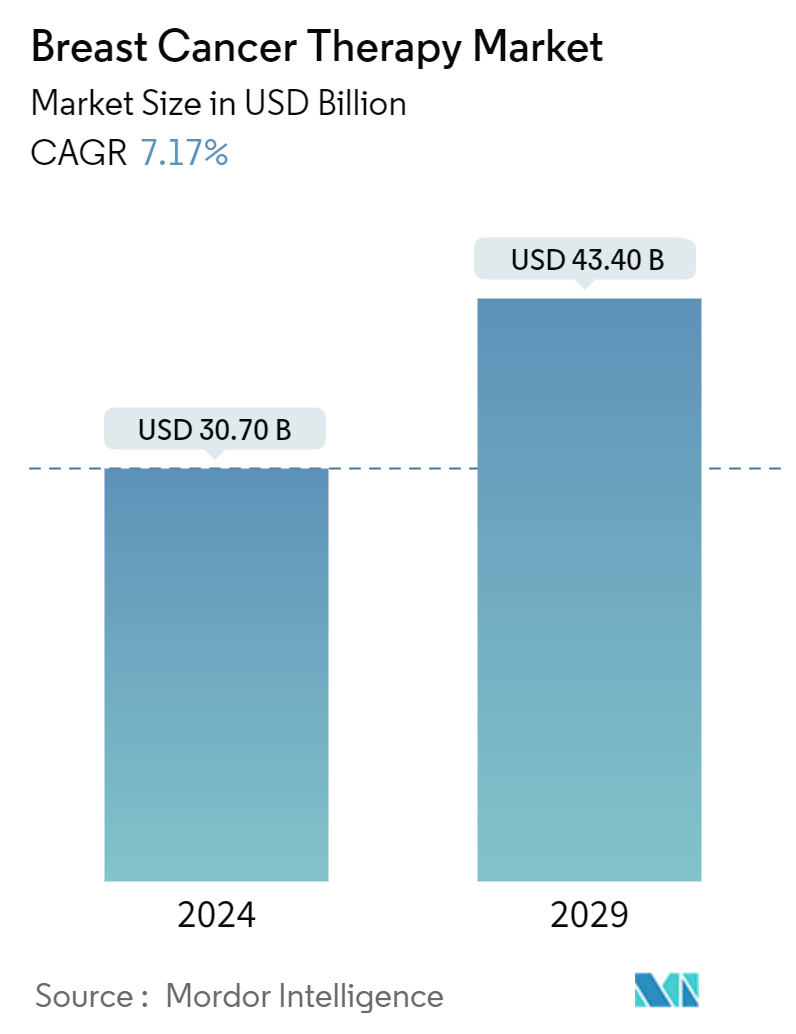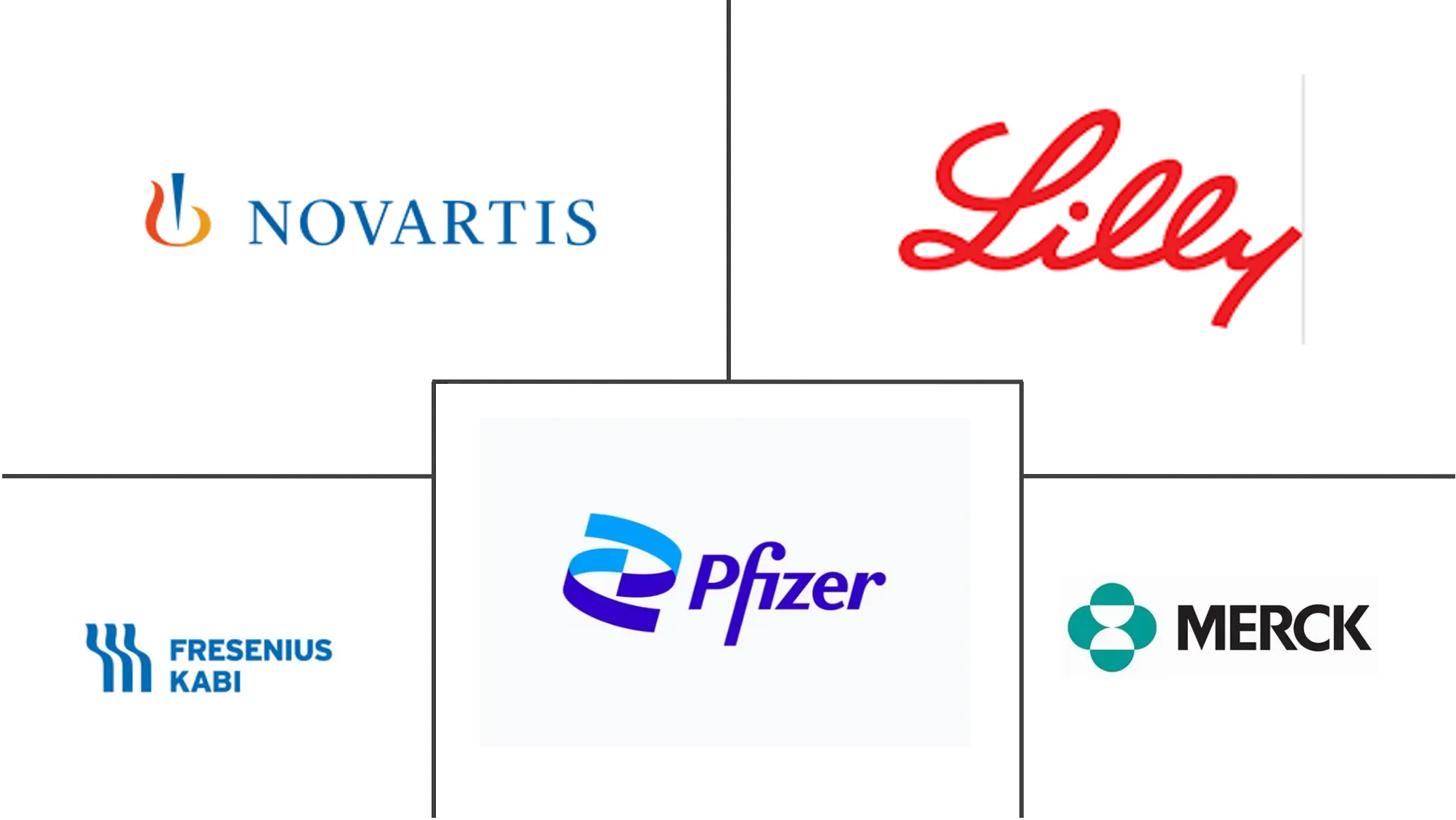
| Study Period | 2019 - 2029 |
| Base Year For Estimation | 2023 |
| Market Size (2024) | USD 30.70 Billion |
| Market Size (2029) | USD 43.40 Billion |
| CAGR (2024 - 2029) | 7.17 % |
| Fastest Growing Market | Asia-Pacific |
| Largest Market | North America |
Major Players
*Disclaimer: Major Players sorted in no particular order |
Breast Cancer Therapy Market Analysis
The Breast Cancer Therapy Market size is estimated at USD 30.70 billion in 2024, and is expected to reach USD 43.40 billion by 2029, growing at a CAGR of 7.17% during the forecast period (2024-2029).
The major factors fueling the market's growth are the high incidence and prevalence rates of breast cancer, increasing investment in research and development, and advancements in cancer biology and pharmacology, promoting drug development.
According to Globocan, in 2020, about 2,261,419 new cancer cases were reported worldwide, contributing to about 11.7% of the total cancer cases. As per canceraustralia.gov.au, in 2021, 20,030 new breast cancer cases were diagnosed in the country (164 males and 19,866 females). The same source reports that in 2021, a person had an estimated 1 in 15 (or 6.7%) risk of being diagnosed with breast cancer by the age of 85 (1 in 8 or 13% for females and 1 in 829 or 0.12% for males). Therefore, the high burden of breast cancer is increasing the demand for breast cancer treatment, thereby contributing to the market's growth.
The increasing focus of research studies by the market players. For instance, in September 2021, Novartis AS collaborated with Solti on HARMONIA, an international, randomized, Phase III, multicenter, and open-label study of Kisqali (ribociclib) versus Ibrance (palbociclib), both in combination with endocrine therapy. This study was on patients with hormone receptor-positive, human epidermal growth factor receptor 2-negative (HR+/HER2-) advanced or metastatic breast cancer with a HER2-enriched (HER2E) intrinsic subtype.
Increasing launches by manufacturers to meet the growing demand for innovative products are expected to drive market growth. For instance, in July 2021, Arvinas Inc. and Pfizer Inc. collaborated to develop and commercialize ARV-471, an investigational oral PROTAC (PROteolysis TArgeting Chimera) estrogen receptor protein degrader. Such factors potentially drive the demand for the adoption of breast cancer therapy worldwide.
On the other hand, the risk of adverse effects of radiation exposure and stringent regulatory scenarios are hindering the market's growth.
Breast Cancer Therapy Industry Segmentation
As per the scope of this report, breast cancer therapy refers to cancer treatment with chemotherapy, targeted therapy, hormonal therapy, etc. These therapies block the growth and proliferation of cancer by interfering with specific molecules, such as DNA or proteins, that are involved in the growth or expansion of cancerous cells. The breast cancer therapy market is segmented by therapy (radiation therapy, targeted therapy, hormonal therapy, and chemotherapy) and geography (North America, Europe, Asia-Pacific, Middle East and Africa, and South America). The report also covers the estimated market sizes and trends for 17 different countries across major regions globally. The report offers the market sizes and forecasts in terms of value (USD million) for the above segments.
| Radiation Therapy | |
| Targeted Therapy | Herceptin |
| Tykerb (Lapatinib) | |
| Afinitor | |
| Other Targeted Therapies | |
| Hormonal Therapy | Selective Estrogen - Receptor Modulators |
| Aromatase Inhibitors | |
| Other Hormonal Therapies | |
| Chemotherapy | Taxanes |
| Anthracyclines | |
| Anti-metabolites | |
| Alkylating Agents | |
| Epothilones |
| North America | United States |
| Canada | |
| Mexico | |
| Europe | Germany |
| United Kingdom | |
| France | |
| Italy | |
| Spain | |
| Rest of Europe | |
| Asia-Pacific | China |
| Japan | |
| India | |
| Australia | |
| South Korea | |
| Rest of Asia-Pacific | |
| Middle East and Africa | GCC |
| South Africa | |
| Rest of Middle East and Africa | |
| South America | Brazil |
| Argentina | |
| Rest of South America |
Breast Cancer Therapy Market Size Summary
The breast cancer therapy market is poised for significant growth over the forecast period, driven by the high incidence and prevalence of breast cancer globally. The market is experiencing a surge in demand due to increased awareness and the rising burden of the disease, which is prompting substantial investments in research and development. Advancements in cancer biology and pharmacology are further propelling drug development, with numerous innovative therapies being introduced to meet the growing needs of patients. Collaborative efforts among major players, such as Novartis and Pfizer, are enhancing the development of targeted therapies, while regulatory approvals in regions like the United States are boosting market confidence and expansion.
North America, particularly the United States, is expected to dominate the breast cancer therapy market, supported by a high incidence rate and a robust pipeline of new products. The competitive landscape is marked by the presence of major pharmaceutical companies, including Novartis AG, Pfizer Inc., and Merck & Co. Inc., which are actively involved in developing and commercializing advanced therapies. The market's growth is also fueled by the increasing number of product launches and the approval of novel treatments, such as Enhertu for HER2-low breast cancer, which address specific subtypes of the disease. Despite challenges like the risk of adverse effects from treatments and stringent regulatory environments, the market is set to expand, driven by ongoing innovation and strategic collaborations.
Breast Cancer Therapy Market Size - Table of Contents
1. MARKET DYNAMICS
- 1.1 Market Overview
-
1.2 Market Drivers
- 1.2.1 High Incidence and Prevalence Rate of Breast Cancer
- 1.2.2 Increasing Investments in R&D
- 1.2.3 Advancements in Cancer Biology and Pharmacology, Promoting Drug Development
-
1.3 Market Restraints
- 1.3.1 Risk of Adverse Effects of Radiation Exposure
- 1.3.2 Stringent Regulatory Scenarios
-
1.4 Porter's Five Forces Analysis
- 1.4.1 Bargaining Power of Suppliers
- 1.4.2 Bargaining Power of Buyers/Consumers
- 1.4.3 Threat of New Entrants
- 1.4.4 Threat of Substitute Products
- 1.4.5 Intensity of Competitive Rivalry
2. MARKET SEGMENTATION (Market Size by Value - USD million)
-
2.1 By Therapy
- 2.1.1 Radiation Therapy
- 2.1.2 Targeted Therapy
- 2.1.2.1 Herceptin
- 2.1.2.2 Tykerb (Lapatinib)
- 2.1.2.3 Afinitor
- 2.1.2.4 Other Targeted Therapies
- 2.1.3 Hormonal Therapy
- 2.1.3.1 Selective Estrogen - Receptor Modulators
- 2.1.3.2 Aromatase Inhibitors
- 2.1.3.3 Other Hormonal Therapies
- 2.1.4 Chemotherapy
- 2.1.4.1 Taxanes
- 2.1.4.2 Anthracyclines
- 2.1.4.3 Anti-metabolites
- 2.1.4.4 Alkylating Agents
- 2.1.4.5 Epothilones
-
2.2 Geography
- 2.2.1 North America
- 2.2.1.1 United States
- 2.2.1.2 Canada
- 2.2.1.3 Mexico
- 2.2.2 Europe
- 2.2.2.1 Germany
- 2.2.2.2 United Kingdom
- 2.2.2.3 France
- 2.2.2.4 Italy
- 2.2.2.5 Spain
- 2.2.2.6 Rest of Europe
- 2.2.3 Asia-Pacific
- 2.2.3.1 China
- 2.2.3.2 Japan
- 2.2.3.3 India
- 2.2.3.4 Australia
- 2.2.3.5 South Korea
- 2.2.3.6 Rest of Asia-Pacific
- 2.2.4 Middle East and Africa
- 2.2.4.1 GCC
- 2.2.4.2 South Africa
- 2.2.4.3 Rest of Middle East and Africa
- 2.2.5 South America
- 2.2.5.1 Brazil
- 2.2.5.2 Argentina
- 2.2.5.3 Rest of South America
Breast Cancer Therapy Market Research FAQs
How big is the Breast Cancer Therapy Market?
The Breast Cancer Therapy Market size is expected to reach USD 32.90 billion in 2025 and grow at a CAGR of 7.17% to reach USD 46.51 billion by 2030.
What is the current Breast Cancer Therapy Market size?
In 2025, the Breast Cancer Therapy Market size is expected to reach USD 32.90 billion.


